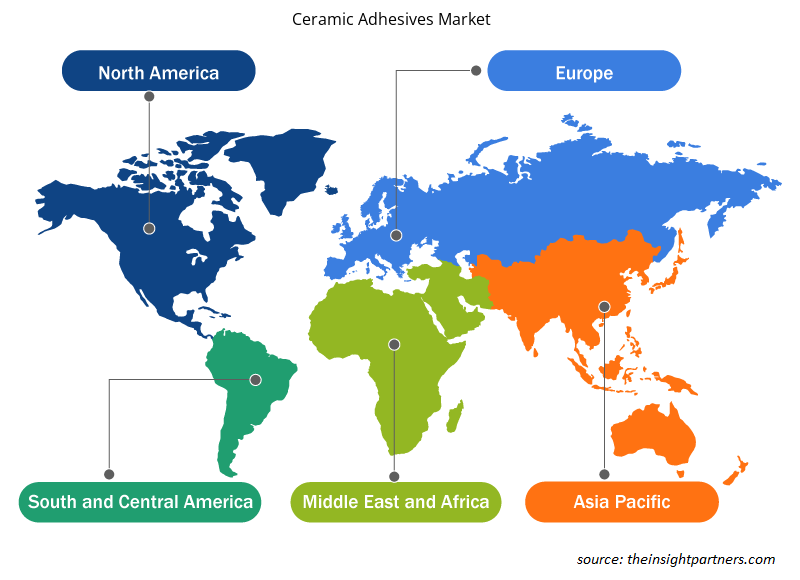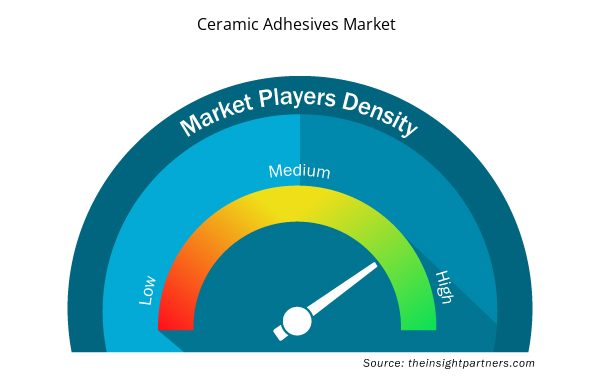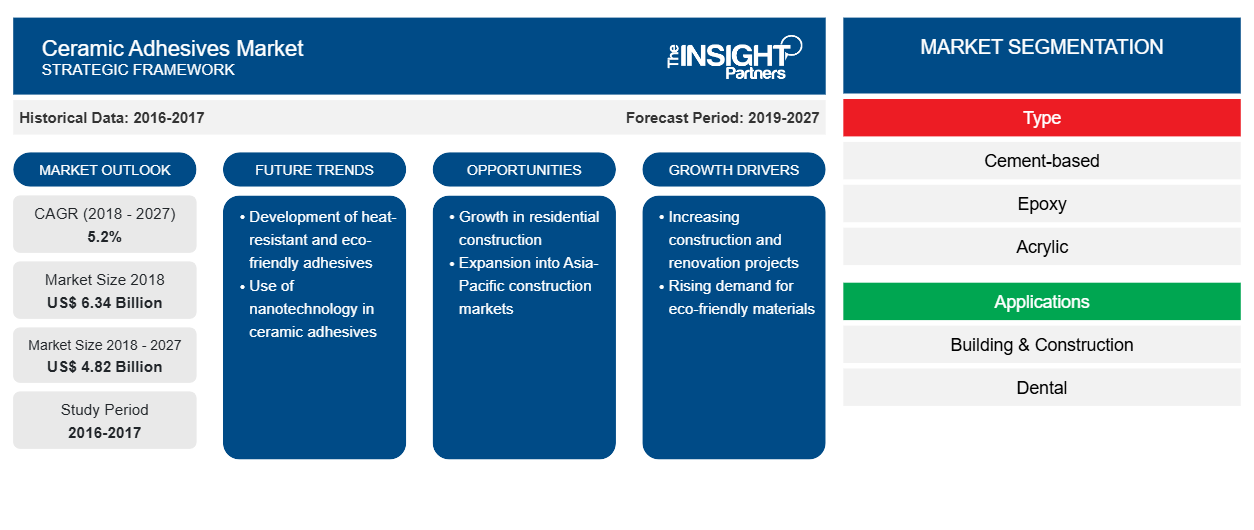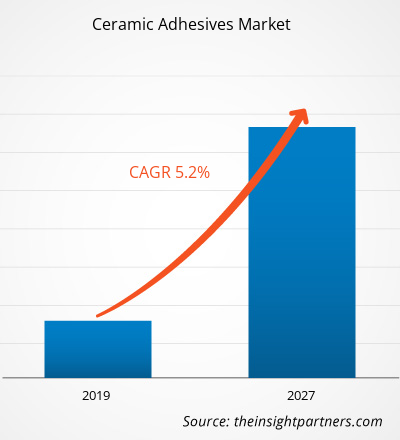2018 年陶瓷粘合剂市场规模为 63.44 亿美元,预计在 2019 年至 2027 年的预测期内将以 5.2% 的复合年增长率增长,到 2027 年将达到 99.318 亿美元。
陶瓷基本上是无机和非金属材料,性质脆硬。它以其良好的热稳定性、电绝缘性、机械强度和耐腐蚀/耐磨性而闻名。有各种工程配方用于粘合陶瓷部件,包括二氧化锆、碳化硼、氧化铝、氮化硅等。通常,陶瓷粘合剂基于无机粘合剂,如金属磷酸盐和碱性硅酸盐,以及氧化铝、二氧化硅、碳、氧化锆粉末填料和氧化镁。陶瓷粘合剂市场广泛采用单组分或双组分系统,具有与有机粘合剂相似的物理形态。陶瓷粘合剂广泛应用于建筑和建筑行业的地板、屋顶和墙面覆盖应用。
预计亚太地区将成为未来几年陶瓷粘合剂产品增长最快的市场。随着建筑、牙科应用等领域的增长,亚太地区国家对陶瓷粘合剂产品的需求大幅上升,从而推动了这些产品在世界其他地区的整体销售。此外,消费者对陶瓷产品用途和好处的认识也推动了该地区市场的增长。此外,制造商正在投资研发活动,以实现陶瓷产品的多样化使用。这也刺激了该地区对该产品的需求。亚太地区在全球陶瓷粘合剂市场中占有最大份额,预计到 2027 年该地区的市场规模将达到 48.169 亿美元。
定制此报告以满足您的需求
您可以免费定制任何报告,包括本报告的部分内容、国家级分析、Excel 数据包,以及为初创企业和大学提供优惠和折扣
- 获取此报告的关键市场趋势。这个免费样品将包括数据分析,从市场趋势到估计和预测。
市场洞察
地板或瓷砖胶粘剂的创新
客户对美观且装饰性瓷砖的需求不断增长,预计将产生对陶瓷粘合剂的额外需求。制造商越来越多地参与陶瓷粘合剂的创新,这些粘合剂环保且挥发性有机化合物浓度低。由于与地板覆盖物广泛使用相关的各种因素,建筑和建筑行业面临着与水分相关的索赔前所未有的增加。这些主要因素包括快速的建筑和施工活动、非传统尺寸地板砖的使用增加、使用不当和指定的粘合剂。但是,如今,陶瓷粘合剂制造商更多地参与开发高质量、改进和创新的产品,这些产品有助于减少水分损害。这最终将导致陶瓷粘合剂市场的增长。此外,陶瓷粘合剂配方师与其供应商和地板覆盖物制造商密切合作,开发易于安装的陶瓷粘合剂产品。陶瓷粘合剂产品正在经过适当的测试,以确保它更好地符合所需的碱度、湿度和温度,以便在指定的应用中发挥作用。瓷砖粘合剂越来越多地被视为现代装饰的新材料,与传统粘合剂相比,其粘合能力更强。此外,机场、商场、零售店和其他商业建筑对装饰性、美观瓷砖的需求不断增长,推动了陶瓷粘合剂市场的发展。
类型洞察
根据类型,陶瓷粘合剂市场细分为水泥基、环氧树脂、丙烯酸、硅树脂、氰基丙烯酸酯等。预计环氧树脂细分市场将在 2019-2027 年的预测期内以最快的速度增长。环氧树脂具有坚固的结构长度和强大的粘合因子,广泛用于填充零件之间的空隙。环氧树脂包含两部分,必须充分混合的树脂和硬化剂。一些制造商发现使用不同颜色的硬化剂和树脂很方便。使用不同颜色的原因是,将它们混合在一起后,产品会提供第三种对比色,从而根据混合的树脂和硬化剂的量产生不同的颜色。环氧树脂有各种挤压样式和不同尺寸。不同的环氧树脂具有多种功能,如保护覆盖、填充和修补。环氧陶瓷粘合剂因其能够为室内水平和垂直瓷砖应用提供牢固的粘合而闻名。环氧陶瓷粘合剂还因其出色的耐高温和边际收缩性而广受欢迎。环氧陶瓷粘合剂非常适合用于瓷砖、采石场、板岩和花岗岩瓷砖。它们还对水分敏感,适合用于使用强力清洁化学品的区域。可以使用环氧陶瓷粘合剂的一些常见区域包括游泳池、浴室、快餐店、大厅、奶牛场、工厂等。
应用程序洞察
根据应用,陶瓷粘合剂市场分为建筑和施工、牙科和其他。预计在 2019-2027 年的预测期内,其他细分市场将以最快的速度增长。在建筑和施工行业中,陶瓷粘合剂主要用于安装瓷砖、地板、屋顶和墙面覆盖物。陶瓷粘合剂用于建筑和施工行业,用于粘合各种瓷砖,例如釉面和无釉瓷砖、瓷器、马赛克和玻化砖,粘合在水平和垂直砌体或内墙和外墙的倾斜表面上。陶瓷粘合剂可轻松应用于多种基材,例如混凝土、水泥灰泥、纤维水泥板、天然石材、石膏板和石膏灰泥。陶瓷粘合剂广泛应用于建筑和施工行业,因为它们具有使用寿命长、抗冲击性好、抗吸水性好、粘结强度高和剪切强度高的特点。由于陶瓷粘合剂以即用型混合物的形式提供,因此易于涂抹,并且涂抹时间更短。易于使用以及最小化劳动力和与劳动力相关的成本使其成为建筑行业青睐的建筑胶粘剂。
Ardex Group、3M、Henkel、HB Fuller 和 Bostik 等是全球陶瓷粘合剂市场的主要参与者。这些公司正在实施新产品开发和并购战略,以扩大客户群并在全球范围内获得显著的市场份额,这反过来又使参与者能够在全球范围内保持其品牌名称。
报告亮点
- 全球陶瓷粘合剂市场不断发展的行业趋势有助于参与者制定有效的长期战略
- 发达市场和发展中市场采用的业务增长战略
- 2017年至2027年全球陶瓷粘合剂市场定量分析
- 各行业全球陶瓷粘合剂需求量估算
- PEST 分析可说明行业内买家和供应商预测市场增长的有效性
- 了解竞争激烈的市场形势和全球陶瓷粘合剂需求的最新发展
- 市场趋势和前景以及推动和抑制全球陶瓷粘合剂市场增长的因素
- 通过了解支撑全球陶瓷粘合剂市场增长的商业利益的战略来进行决策过程
- 全球陶瓷粘合剂市场规模(按市场不同节点)
- 全球陶瓷粘合剂市场的详细概述和细分,以及行业动态
- 全球陶瓷胶粘剂市场规模各地区分布情况及发展机遇
陶瓷粘合剂市场区域洞察
Insight Partners 的分析师已详尽解释了预测期内影响陶瓷粘合剂市场的区域趋势和因素。本节还讨论了北美、欧洲、亚太地区、中东和非洲以及南美和中美洲的陶瓷粘合剂市场细分和地理位置。

- 获取陶瓷胶粘剂市场的区域特定数据
陶瓷粘合剂市场报告范围
| 报告属性 | 细节 |
|---|---|
| 2018 年市场规模 | 63.4 亿美元 |
| 2027 年市场规模 | 48.2亿美元 |
| 全球复合年增长率(2018 - 2027) | 5.2% |
| 史料 | 2016-2017 |
| 预测期 | 2019-2027 |
| 涵盖的领域 | 按类型
|
| 覆盖地区和国家 | 北美
|
| 市场领导者和主要公司简介 |
|
陶瓷粘合剂市场参与者密度:了解其对业务动态的影响
陶瓷粘合剂市场正在快速增长,这得益于最终用户需求的不断增长,而这些需求又源于消费者偏好的不断变化、技术进步以及对产品优势的认识不断提高等因素。随着需求的增加,企业正在扩大其产品范围,进行创新以满足消费者的需求,并利用新兴趋势,从而进一步推动市场增长。
市场参与者密度是指在特定市场或行业内运营的企业或公司的分布情况。它表明在给定市场空间中,相对于其规模或总市场价值,有多少竞争对手(市场参与者)存在。
在陶瓷胶粘剂市场运营的主要公司有:
- 3M
- 汉高
- 富勒
- 亚地斯集团
- 巴斯夫
免责声明:上面列出的公司没有按照任何特定顺序排列。

- 了解陶瓷粘合剂市场主要参与者概况
全球陶瓷粘合剂市场(按类型)
- 水泥基
- 环氧树脂
- 丙烯酸纤维
- 其他的
全球陶瓷粘合剂市场(按应用划分)
- 建筑和施工
- 牙科
- 其他的
公司简介
- 亨克尔股份公司
- 3M
- 富勒
- 亚地斯集团
- 巴斯夫
- 博斯蒂克
- 马贝水疗中心
- 诺克罗斯公司
- 圣戈班
- 西卡公司
- 历史分析(2 年)、基准年、预测(7 年)及复合年增长率
- PEST 和 SWOT 分析
- 市场规模价值/数量 - 全球、区域、国家
- 行业和竞争格局
- Excel 数据集


- USB Device Market
- Trade Promotion Management Software Market
- Hair Wig Market
- Toothpaste Market
- Electronic Signature Software Market
- Arterial Blood Gas Kits Market
- Fishing Equipment Market
- Artificial Turf Market
- Cosmetic Bioactive Ingredients Market
- Artificial Intelligence in Healthcare Diagnosis Market

Report Coverage
Revenue forecast, Company Analysis, Industry landscape, Growth factors, and Trends

Segment Covered
This text is related
to segments covered.

Regional Scope
North America, Europe, Asia Pacific, Middle East & Africa, South & Central America

Country Scope
This text is related
to country scope.
常见问题
Cement-based ceramic adhesives hold the largest share in the global market, owing to its larges scale applications in building and construction. The epoxy ceramic adhesives segment may grow at a high rate, due to its improved properties.
The major players operating in the Ceramic Adhesives Market, includes Henkel AG & Company, 3M, HB Fuller, Ardex Group, and BASF SE.
The Asia region is the highest consumer of ceramic adhesives due to high demand from countries such as India and China. The Asia region is expected to grow at the highest rate during the next 5 to 6 years.
Trends and growth analysis reports related to Chemicals and Materials : READ MORE..
The List of Companies
- 3M
- Henkel
- H.B Fuller
- Ardex Group
- BASF SE
- Bostik
- Kerakoll
- Mapei Spa.
- Sika AG
- Norcros Plc.
The Insight Partners performs research in 4 major stages: Data Collection & Secondary Research, Primary Research, Data Analysis and Data Triangulation & Final Review.
- Data Collection and Secondary Research:
As a market research and consulting firm operating from a decade, we have published and advised several client across the globe. First step for any study will start with an assessment of currently available data and insights from existing reports. Further, historical and current market information is collected from Investor Presentations, Annual Reports, SEC Filings, etc., and other information related to company’s performance and market positioning are gathered from Paid Databases (Factiva, Hoovers, and Reuters) and various other publications available in public domain.
Several associations trade associates, technical forums, institutes, societies and organization are accessed to gain technical as well as market related insights through their publications such as research papers, blogs and press releases related to the studies are referred to get cues about the market. Further, white papers, journals, magazines, and other news articles published in last 3 years are scrutinized and analyzed to understand the current market trends.
- Primary Research:
The primarily interview analysis comprise of data obtained from industry participants interview and answers to survey questions gathered by in-house primary team.
For primary research, interviews are conducted with industry experts/CEOs/Marketing Managers/VPs/Subject Matter Experts from both demand and supply side to get a 360-degree view of the market. The primary team conducts several interviews based on the complexity of the markets to understand the various market trends and dynamics which makes research more credible and precise.
A typical research interview fulfils the following functions:
- Provides first-hand information on the market size, market trends, growth trends, competitive landscape, and outlook
- Validates and strengthens in-house secondary research findings
- Develops the analysis team’s expertise and market understanding
Primary research involves email interactions and telephone interviews for each market, category, segment, and sub-segment across geographies. The participants who typically take part in such a process include, but are not limited to:
- Industry participants: VPs, business development managers, market intelligence managers and national sales managers
- Outside experts: Valuation experts, research analysts and key opinion leaders specializing in the electronics and semiconductor industry.
Below is the breakup of our primary respondents by company, designation, and region:

Once we receive the confirmation from primary research sources or primary respondents, we finalize the base year market estimation and forecast the data as per the macroeconomic and microeconomic factors assessed during data collection.
- Data Analysis:
Once data is validated through both secondary as well as primary respondents, we finalize the market estimations by hypothesis formulation and factor analysis at regional and country level.
- Macro-Economic Factor Analysis:
We analyse macroeconomic indicators such the gross domestic product (GDP), increase in the demand for goods and services across industries, technological advancement, regional economic growth, governmental policies, the influence of COVID-19, PEST analysis, and other aspects. This analysis aids in setting benchmarks for various nations/regions and approximating market splits. Additionally, the general trend of the aforementioned components aid in determining the market's development possibilities.
- Country Level Data:
Various factors that are especially aligned to the country are taken into account to determine the market size for a certain area and country, including the presence of vendors, such as headquarters and offices, the country's GDP, demand patterns, and industry growth. To comprehend the market dynamics for the nation, a number of growth variables, inhibitors, application areas, and current market trends are researched. The aforementioned elements aid in determining the country's overall market's growth potential.
- Company Profile:
The “Table of Contents” is formulated by listing and analyzing more than 25 - 30 companies operating in the market ecosystem across geographies. However, we profile only 10 companies as a standard practice in our syndicate reports. These 10 companies comprise leading, emerging, and regional players. Nonetheless, our analysis is not restricted to the 10 listed companies, we also analyze other companies present in the market to develop a holistic view and understand the prevailing trends. The “Company Profiles” section in the report covers key facts, business description, products & services, financial information, SWOT analysis, and key developments. The financial information presented is extracted from the annual reports and official documents of the publicly listed companies. Upon collecting the information for the sections of respective companies, we verify them via various primary sources and then compile the data in respective company profiles. The company level information helps us in deriving the base number as well as in forecasting the market size.
- Developing Base Number:
Aggregation of sales statistics (2020-2022) and macro-economic factor, and other secondary and primary research insights are utilized to arrive at base number and related market shares for 2022. The data gaps are identified in this step and relevant market data is analyzed, collected from paid primary interviews or databases. On finalizing the base year market size, forecasts are developed on the basis of macro-economic, industry and market growth factors and company level analysis.
- Data Triangulation and Final Review:
The market findings and base year market size calculations are validated from supply as well as demand side. Demand side validations are based on macro-economic factor analysis and benchmarks for respective regions and countries. In case of supply side validations, revenues of major companies are estimated (in case not available) based on industry benchmark, approximate number of employees, product portfolio, and primary interviews revenues are gathered. Further revenue from target product/service segment is assessed to avoid overshooting of market statistics. In case of heavy deviations between supply and demand side values, all thes steps are repeated to achieve synchronization.
We follow an iterative model, wherein we share our research findings with Subject Matter Experts (SME’s) and Key Opinion Leaders (KOLs) until consensus view of the market is not formulated – this model negates any drastic deviation in the opinions of experts. Only validated and universally acceptable research findings are quoted in our reports.
We have important check points that we use to validate our research findings – which we call – data triangulation, where we validate the information, we generate from secondary sources with primary interviews and then we re-validate with our internal data bases and Subject matter experts. This comprehensive model enables us to deliver high quality, reliable data in shortest possible time.


 获取此报告的免费样本
获取此报告的免费样本